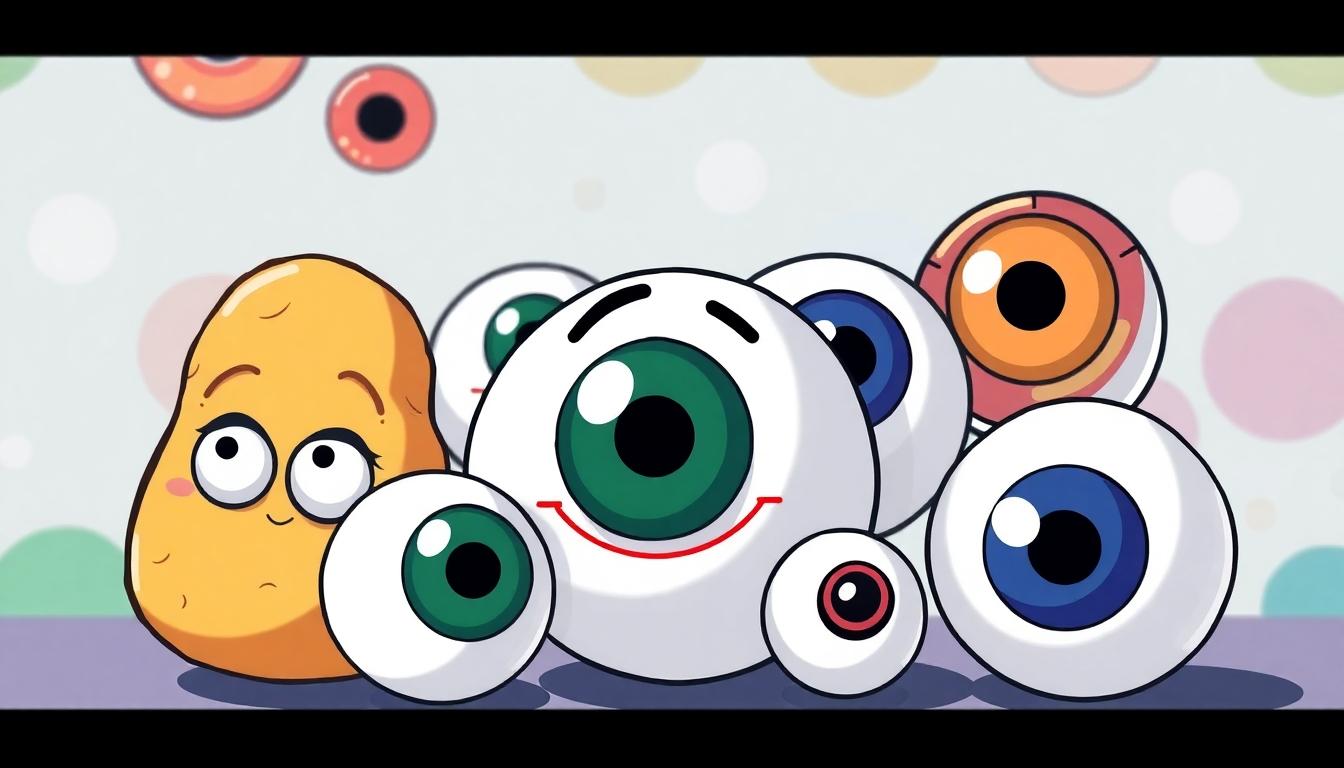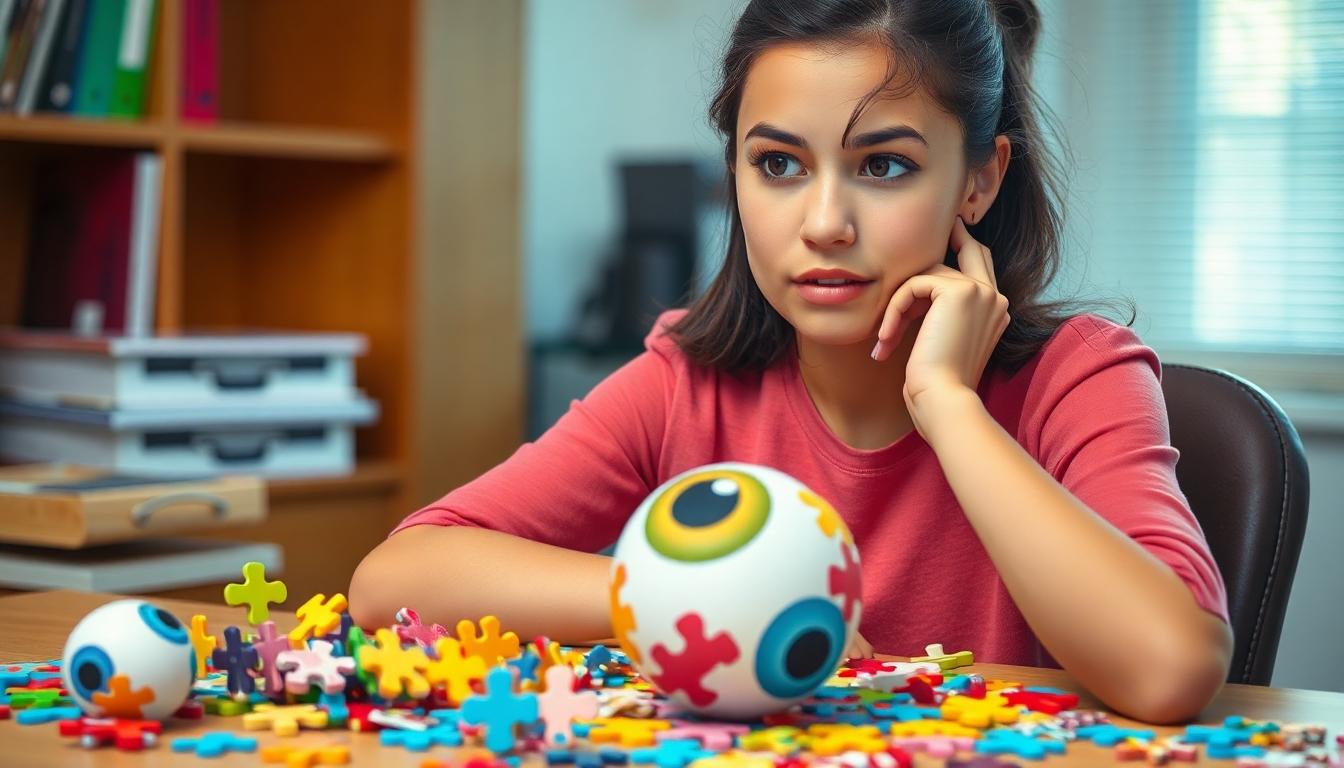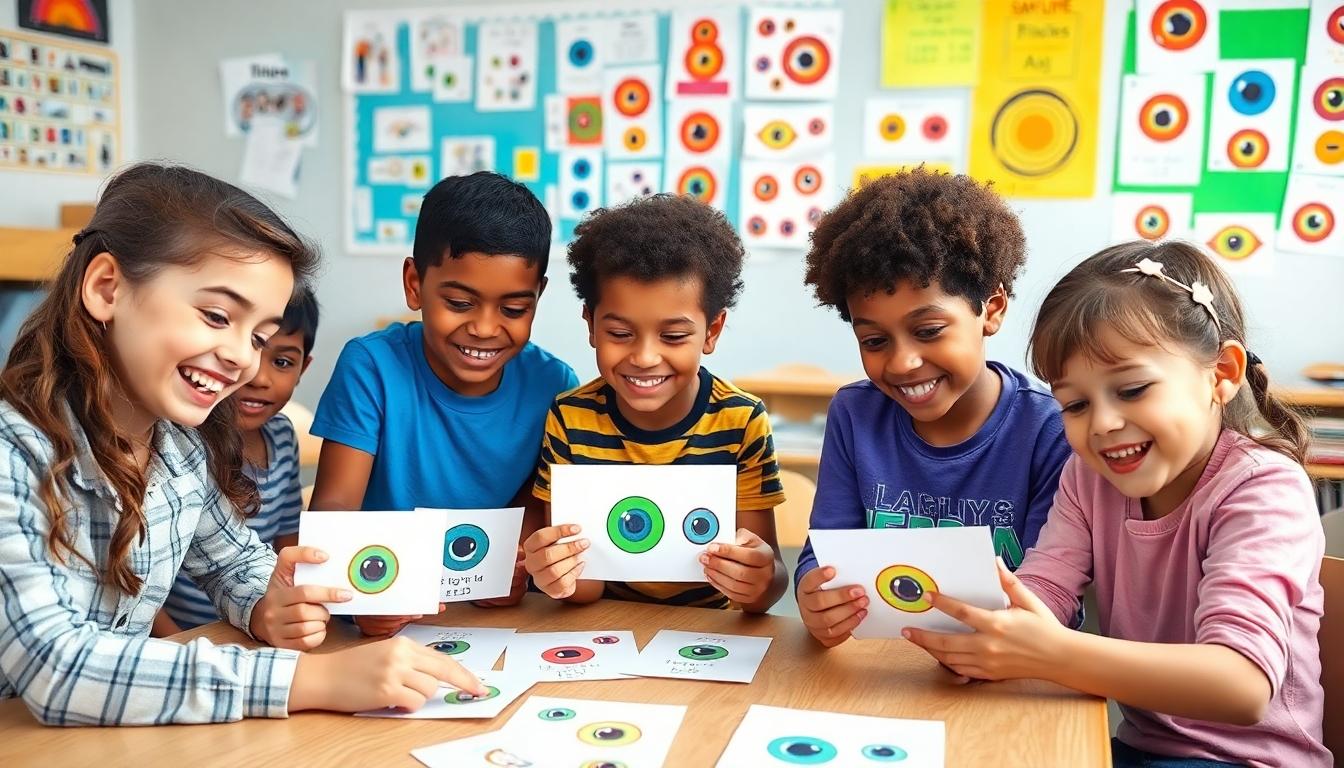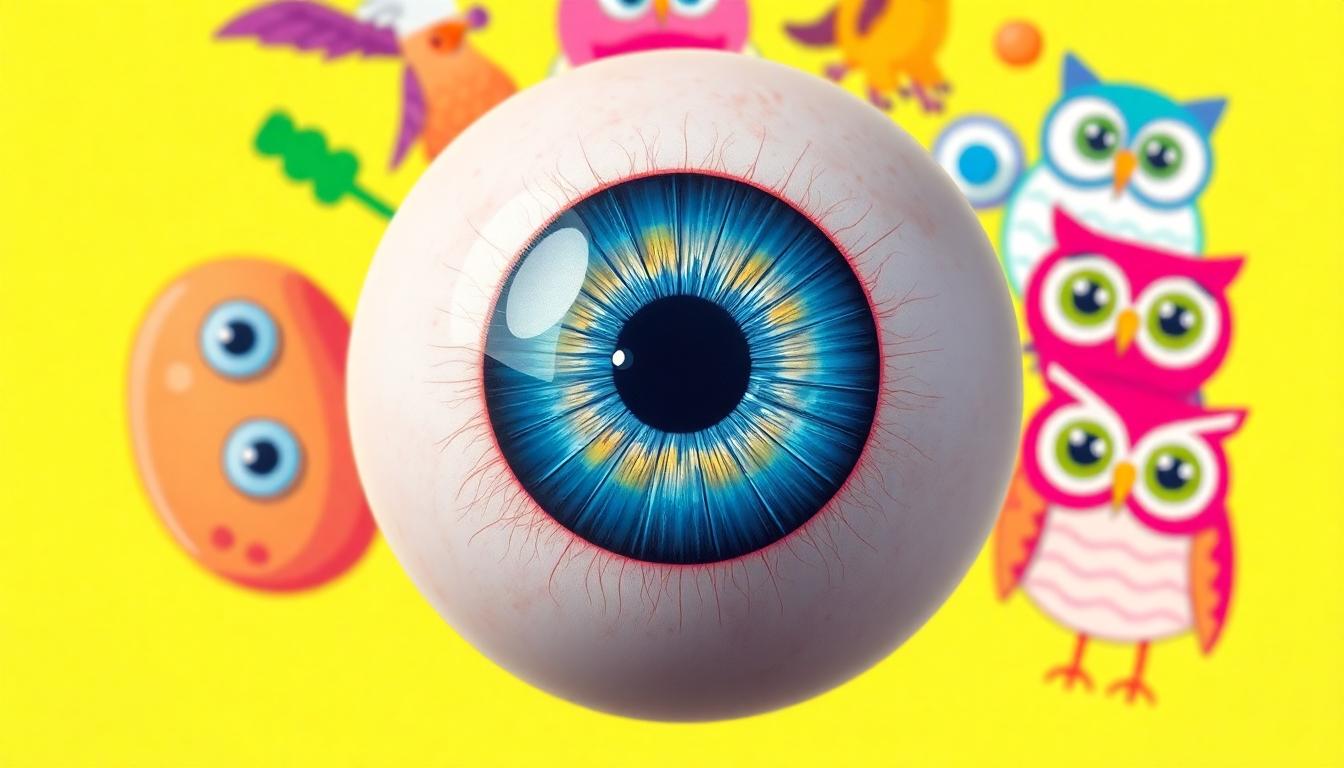Looking for a brain teaser that’ll make you look twice? Eyeball riddles are the perfect mental workout that combine visual perception with clever wordplay. We’ve gathered the most entertaining optical challenges that’ll test your visual thinking and problem-solving skills.
These captivating puzzles often hide their answers in plain sight, requiring you to think beyond the obvious. Whether you’re trying to entertain kids at a party, challenge colleagues during a break, or simply keep your mind sharp, eyeball riddles offer a fun way to exercise your brain. They’re especially excellent for developing critical thinking in children while keeping adults on their toes too.
What Are Eyeball Riddles and Why They Challenge Your Brain
Eyeball riddles are clever word puzzles that require you to decipher a hidden message or word by interpreting visual patterns, letter arrangements, or symbolic representations. They function as visual brain teasers where the answer is often concealed in plain sight, making you look at the problem from different angles. These puzzles typically present combinations of letters, numbers, shapes, or positions that form a recognizable word or phrase when properly decoded.
The brain-challenging nature of eyeball riddles stems from their unique cognitive demands. Your brain must process visual information while simultaneously captivating language centers to decode the hidden meaning. This dual processing requirement activates multiple brain regions at once, creating a mental workout that strengthens neural pathways. Research shows that these types of puzzles stimulate both the left hemisphere (responsible for logical analysis) and the right hemisphere (handling visual processing and creative connections).
What makes these riddles particularly challenging is their reliance on lateral thinking rather than straightforward logic. Many eyeball riddles play with perspective, requiring you to literally “think outside the box” by considering alternative interpretations of the visual elements presented. For instance, a riddle might position letters in a certain way to indicate direction, size relationships, or physical positioning that hints at the solution.
Neuroscientists have observed that solving visual puzzles like eyeball riddles activates the brain’s prefrontal cortex, which handles complex problem-solving and decision-making functions. This activation explains why you feel a distinct mental satisfaction—often called the “Aha! moment”—when you finally crack a challenging eyeball riddle after repeated attempts.
Regular engagement with eyeball riddles provides valuable cognitive benefits beyond mere entertainment. These puzzles help improve your:
- Visual perception skills
- Pattern recognition abilities
- Creative problem-solving approaches
- Mental flexibility
- Attention to detail
- Linguistic processing speed
The deceptive simplicity of eyeball riddles is precisely what makes them so addictive and effective as brain exercises. They appear straightforward at first peek but require sophisticated mental manipulation to solve, creating the perfect balance between accessibility and challenge that keeps both children and adults engaged in the puzzle-solving process.
10 Classic Eyeball Riddles That Will Make You Look Twice

- What has an eye but can’t see?
The answer is a potato. This classic riddle plays on the fact that potatoes have “eyes” (small buds) but lack actual vision capabilities, creating a perfect visual pun.
- I come in pairs, I blink, I stare.
Eyes are the answer to this straightforward yet clever riddle. The description captures the essential characteristics of our visual organs in just a few words.
- I’m part of the eye, small and round, Helping the eye hear without a sound.
The pupil is the answer here. This riddle employs poetic license by suggesting pupils assist with hearing, creating an intriguing misdirection while describing their circular shape.
- I let in light, and then I bend, Sending the image to the brain in the end.
This describes the lens of the eye. The riddle accurately portrays how our eye lenses function by bending light and transmitting visual information to our brains.
- I’m a tiny window, curved just so, Through me, the industry begins to show.
The cornea serves as this “tiny window.” Its curved shape is essential for properly refracting light as it enters the eye, making this riddle both poetic and anatomically correct.
- I’m as delicate as lace, but I’m strong too, I keep your eyes safe, watching over you.
Eyelashes are the subject of this protective riddle. The contrast between their delicate appearance and vital protective function creates an captivating puzzle.
- I’m the dot in the middle, don’t look away, I grow and shrink depending on the day.
Pupils are fascinating because they constantly change size based on light conditions. This riddle captures their ever-changing nature and central position in the eye.
- I have billions of cells, all working fast, Processing what you see, from first to last.
The retina contains photoreceptor cells that process visual information. This riddle highlights its complexity and crucial role in vision.
- What has eyes but can’t cry?
Common answers include dolls or toys with painted or plastic eyes. This riddle, like the potato riddle, plays on the multiple meanings of “eyes.”
- I’m a part of your face, there’s one on each side, Without me, you’d need a guide.
Eyes are essential for independent navigation. This riddle emphasizes their importance while noting their paired nature on our faces.
Visual Perception Teasers
Visual perception teasers challenge our brain’s ability to process what we see in unexpected ways. These riddles force us to reconsider everyday objects and their functions from new perspectives. Many eyeball riddles rely on dual meanings of words related to sight or vision, requiring solvers to think beyond literal interpretations. Our brains must navigate competing visual and linguistic information, making these puzzles particularly captivating for developing flexible thinking patterns. The satisfaction from solving these teasers comes from the cognitive shift that occurs when we suddenly see the connection between the clue and its clever answer.
Hidden Object Challenges
Hidden object challenges take visual riddles to another level by incorporating concealed elements within images or text descriptions. These puzzles might involve finding exact shapes nested within larger pictures or identifying obscured objects based on partial descriptions. The challenge intensifies when solvers must mentally manipulate visual information to discover hidden patterns or meanings. Eyeball-themed hidden object challenges often play with concepts like perspective, negative space, and visual puns. Training your brain with these challenges can enhance visual discrimination skills and attention to detail, making them valuable exercises for improving overall cognitive function and visual processing speed.
How to Solve Eyeball Riddles: Tips and Strategies

Eyeball riddles test both your perceptual and cognitive skills by cleverly incorporating eye anatomy, vision metaphors, and optical illusions. Solving these brain teasers requires a combination of pattern recognition, lateral thinking, and basic anatomical knowledge.
Pattern Recognition Techniques
Developing strong pattern recognition is essential for cracking eyeball riddles. Focus on identifying wordplay and double meanings that frequently appear in these puzzles. Biometric clues often reference exact eye parts like the cornea (the curved, light-focusing structure) or pupil (the light-regulating aperture). Many riddles employ metaphorical language, anthropomorphizing eye components—for instance, referring to an eyelid as a “window of light.” Rhyme schemes provide another valuable hint, with many eyeball riddles pairing words that rhyme with “eye” or eye-related terms. When you encounter phrases like “I help you grow” paired with a rhyme for “eye,” you’re likely on the right track to finding the solution.
Using Peripheral Vision
Success with eyeball riddles often requires looking beyond the obvious. Broaden your focus to treat the entire riddle holistically instead of fixating solely on literal “eyeball” references. Terms like “reflect feelings” might signify the eye’s emotional expressiveness rather than a exact part. Practice contextual cross-referencing by connecting clues such as “adjusting view” to eye muscles or “open/close” to eyelids. The elimination method proves particularly effective—narrow down potential answers by excluding anatomical features that don’t match the riddle’s description. For instance, if the riddle mentions something thin and protective, you can eliminate the iris as a potential answer while considering eyelashes. This peripheral thinking approach helps you see connections that aren’t immediately obvious but make perfect sense once discovered.
7 Benefits of Solving Eyeball Riddles for Visual Development

Enhances Eye-Hand Coordination
Solving eyeball riddles significantly improves eye-hand coordination through activities that demand precise visual-motor integration. When we engage with these puzzles, our brain must process visual information and coordinate appropriate physical responses simultaneously. Strategy games like chess and checkers that often accompany visual riddles require this exact skill, training our visual system to work in harmony with our motor functions. This coordination becomes essential not just for puzzle-solving but transfers to many daily activities requiring precision.
Strengthens Visual Tracking
Eyeball riddles train our eyes to follow moving elements or scan complex visual fields, developing crucial visual tracking abilities. Games involving ball play or moving targets particularly excel at building this skill, which directly supports reading fluency and sports performance. As we track objects or search for hidden elements within riddles, our eyes learn to move smoothly and precisely across visual spaces. This tracking proficiency forms the foundation for efficient reading patterns and improved sports performance.
Boosts Visual Processing
Regular engagement with eyeball riddles dramatically enhances the brain’s ability to rapidly interpret visual information. These puzzles demand quick analysis of visual details, training our minds to process incoming visual data more efficiently. Hidden-picture puzzles and complex visual riddles force our visual system to distinguish between relevant and irrelevant information instantly. This refined processing speed transfers to academic and professional tasks requiring quick visual assessment.
Develops Visual Closure
Eyeball riddles help us master visual closure—the ability to identify complete objects from partial visual information. Activities like completing half-drawn figures or recognizing fragmented shapes in puzzles strengthen this skill substantially. Children particularly benefit as this ability directly supports letter and number recognition in early reading development. Our brains learn to fill in missing visual information based on context and prior knowledge, a skill essential for efficient reading.
Improves Visual Memory
Strategy-based puzzles within the eyeball riddle category significantly strengthen visual memory capabilities. Games like Sudoku and tangrams require us to remember spatial patterns and relationships between visual elements. This enhanced retention of visual information supports problem-solving abilities and academic performance across subjects. Visual memory improvements help us recognize patterns more quickly in subsequent encounters, building efficiency in learning and recall.
Refines Peripheral Vision
Team-based riddle solving and board games associated with visual puzzles sharpen peripheral vision awareness. These activities train us to maintain focus on central visual tasks while remaining aware of surrounding visual information. Improved peripheral vision contributes to better spatial awareness in daily activities like driving and handling crowded spaces. This expanded visual field awareness creates a more complete understanding of our environment.
Supports Cognitive Growth
Beyond pure visual benefits, eyeball riddles engage multiple cognitive domains simultaneously, fostering comprehensive mental development. These puzzles activate logic, reasoning, and creative thinking pathways while providing structured challenges that reduce frustration. The multi-faceted nature of eyeball riddles creates connections between various cognitive skills, strengthening overall brain function. This cognitive integration helps develop a more flexible and adaptable mind capable of addressing diverse challenges.
Eyeball Riddles for Different Age Groups and Skill Levels

We’ve curated special eyeball riddles that cater to various age groups and cognitive abilities, ensuring everyone can enjoy these visual brain teasers regardless of their experience level.
Kid-Friendly Visual Puzzles
Kid-friendly eyeball riddles use simple concepts and playful language that children can easily grasp while still providing an entertaining challenge. These puzzles introduce younger minds to the joy of wordplay through accessible visual concepts.
- What has eyes but can’t see?
Answer: A potato. This classic riddle introduces children to the concept that “eyes” can refer to something beyond human anatomy.
- I have lashes but no whip, I open wide, but I’m not a zip.
Answer: An eye. Children love this riddle because it compares familiar objects to parts of the eye in a way that’s both educational and entertaining.
- I help you blink, I let you peek. When you’re sleepy, I can get weak.
Answer: Eyelid. This rhyming riddle teaches kids about eye anatomy while challenging them to think about the function of eyelids in a creative way.
Advanced Optical Illusion Riddles
Advanced eyeball riddles incorporate more detailed knowledge of ocular anatomy and function, creating sophisticated challenges for older children, teens, and adults. These puzzles often require exact knowledge about the eye’s structure or optical terminology.
- I’m part of the eye, small and round, Helping the eye hear without a sound. I let in light, guiding the way, What am I, working night and day?
Answer: Pupil. This complex riddle uses metaphor to describe how the pupil functions as the eye’s “listening” device by taking in visual information.
- I come in brown, green, or blue, and I’m always in sight. What am I?
Answer: Iris. Solvers must recognize the description of the colored part of the eye that’s literally “always in sight” yet also hidden in plain view.
- I am clear like glass but help you see, I’m shaped like a dome, so carefully.
Answer: Cornea. This riddle challenges players to identify the transparent, dome-shaped front surface of the eye that plays a crucial role in focusing light.
Digital vs. Print Eyeball Riddles: Which Format Works Best

Visual Fatigue Considerations
Print formats offer important advantages when it comes to eye comfort during extended riddle-solving sessions. Traditional paper puzzles reduce visual strain compared to their digital counterparts, especially during lengthy brain-teasing sessions. Digital screens emit light directly into your eyes, potentially causing discomfort after prolonged exposure. Studies show that non-e-reader devices particularly contribute to eye fatigue when users engage with detailed visual tasks like eyeball riddles. The physical ink and paper experience of print materials mimics natural reading conditions, allowing for more comfortable extended use without the eye strain associated with backlit screens.
Engagement and Preference Factors
Digital platforms excel at creating interactive and ever-changing puzzle experiences that print simply can’t match. Interactive elements such as timed challenges, animated clues, and immediate feedback enhance engagement in digital eyeball riddles. Traditional puzzle enthusiasts still gravitate toward print formats for classic brain teasers like crosswords and static visual riddles. Many solvers appreciate the tactile experience of marking up a physical puzzle with notes and potential answers. Digital formats shine brightest when they leverage their unique capabilities to transform static eyeball riddles into responsive, adaptive challenges that react to user inputs.
Accessibility and Innovation Features
Digital eyeball riddles offer remarkable accessibility advantages through customization options. Users can adjust text size, contrast, and brightness to accommodate various visual needs or preferences. Modern technology enables innovative approaches to eye-based challenges that weren’t previously possible, including AI-generated imagery and reflective inconsistencies. Print puzzles maintain a consistent advantage by avoiding screen glare issues that can interfere with solving intricate visual riddles. The familiar tactile experience of print materials provides a comforting, distraction-free solving environment without notifications or battery concerns.
Detection Complexity Differences
Emerging digital tools introduce fascinating new dimensions to eyeball riddles that traditional print cannot replicate. AI-generated images create sophisticated visual puzzles that test observation skills in novel ways, such as analyzing eye reflections to identify inconsistencies. Digital formats allow for multilayered riddles with interactive elements that reveal new clues as solvers progress. Print riddles maintain their charm through clarity and focused simplicity that encourages deep concentration without technological distractions. The static nature of print actually benefits certain types of visual riddles where consistent reference points aid pattern recognition.
| Format | Strengths | Limitations |
|---|---|---|
| Less eye strain, tactile experience, no glare | Static content, limited interactivity | |
| Digital | Adjustable text size, interactive elements, creative innovation | Higher eye fatigue, screen glare issues |
We’ve found that choosing between digital and print formats for eyeball riddles eventually depends on your exact needs and solving environment. Print formats excel in comfort for extended solving sessions while digital platforms offer unmatched interactivity and innovative puzzle mechanics. Your choice might vary based on the complexity of the riddles, your visual comfort preferences, and whether you value technological enhancements over traditional solving experiences.
Creating Your Own Eyeball Riddles: A Step-by-Step Guide

Step 1: Choose a Theme
Selecting an appropriate theme forms the foundation of any good eyeball riddle. We recommend focusing on vision-related concepts such as sight, perception, or exact eye components like lenses or pupils. Themes provide essential context that guides your creative process and helps solvers connect with the underlying concept. Your chosen theme will naturally influence the wordplay and metaphors you’ll use throughout the riddle.
Step 2: Start With the Answer
Beginning with your intended answer is crucial for crafting an effective eyeball riddle. We’ve found that identifying your target answer—whether it’s “eyeball,” “lens,” or “sunglasses”—helps structure the clues more cohesively. This reverse-engineering approach ensures your riddle contains appropriate hints that lead solvers to the correct conclusion without being overly obvious or impossibly vague.
Step 3: Use Wordplay and Metaphors
Incorporating clever wordplay and vivid metaphors elevates ordinary riddles into memorable brain teasers. Your eyeball riddles should leverage linguistic devices that create unexpected connections between concepts. For instance, phrases like “I see but don’t look” might cleverly reference windows or mirrors. These playful language elements engage solvers’ creativity and prompt them to think beyond literal interpretations.
Step 4: Write and Rewrite
Drafting your initial riddle is just the beginning of the creative process. Many successful riddle creators go through multiple revisions to fine-tune their wordplay and clarity. Each revision should aim to strike the perfect balance between challenge and solvability. Pay special attention to your word choice, ensuring that clues are precise enough to guide solvers while maintaining the fun puzzle element.
Step 5: Test and Refine
Sharing your riddles with others provides invaluable feedback about their effectiveness. We suggest testing your eyeball riddles on friends or family members who represent your target audience. Their reactions will reveal whether your riddle hits the sweet spot of difficulty—challenging enough to be satisfying but not so obscure that it becomes frustrating. Use this feedback to make final adjustments to your riddle’s wording or structure.
Example Riddles
“I’m round and full, essential to see” offers a straightforward yet effective riddle that could refer to a lens or eyeball itself. The simplicity of this format makes it accessible for beginners while still requiring some lateral thinking.
“I work with your eyes, but I’m out of sight” presents a more complex riddle that might describe the brain’s visual processing center or vision aids like contact lenses. This example demonstrates how incorporating anatomical knowledge can create more sophisticated eyeball riddles.
How Eyeball Riddles Compare to Other Brain Teasers

Primary Focus
Eyeball riddles stand apart from traditional brain teasers through their unique concentration on visual and ocular references. They typically revolve around clever wordplay involving literal eyes (like “I have billions of cells, all working fast” with the answer being “retina”) or metaphorical “eyes” found in everyday objects (such as “What has eyes but can’t see?” where the answer is “potato”). Logic puzzles, in contrast, prioritize deductive reasoning skills through scenarios that require step-by-step problem-solving. Traditional enigmas tend to employ metaphorical language, while conundra rely heavily on puns or absurd premises that challenge conventional thinking patterns.
Structure and Format
The structure of eyeball riddles blends literal and figurative language centered around anatomical or symbolic eye references. Many use clever descriptions of eye parts (like “I’m the dot in the middle” referring to the pupil) to create captivating puzzles that teach while entertaining. Other brain teasers focus on situational logic or abstract concepts without the specialized focus on a single theme or body part. Eyeball riddles create a unique bridge between anatomical education and linguistic creativity, making them particularly valuable for memory retention about ocular structures.
Cognitive Benefits
We find that eyeball riddles specifically target pattern recognition and lateral thinking skills, often leveraging biological terminology in ways that enhance scientific vocabulary retention. These riddles activate multiple brain regions simultaneously as solvers must process both visual imagery and linguistic clues. Lateral puzzles demand creative problem-solving approaches but lack the specialized focus on anatomical structures. Advanced logic puzzles typically require more sophisticated reasoning capabilities without the visual element that makes eyeball riddles so accessible to diverse audiences.
Target Audience
Eyeball riddles have remarkable versatility in their appeal across age groups. Simple versions work wonderfully for children developing basic vocabulary skills while more complex variations challenge adults with advanced anatomical knowledge. Their dual nature—combining education with entertainment—makes them appropriate for both casual and educational settings. Advanced logic puzzles typically cater to older audiences due to their nuanced reasoning requirements, limiting their accessibility compared to the broader appeal of eye-themed riddles.
Riddle Examples
| Riddle Type | Example | Answer |
|---|---|---|
| Eyeball (literal) | “Round and full, essential to see” | Eyeball |
| Eyeball (metaphorical) | “What has eyes but can’t see?” | Potato |
| Conundrum | “Five brothers working” | Chess partner |
The unique positioning of eyeball riddles in the broader brain teaser industry demonstrates their special value for both entertainment and educational purposes. Their focused theme provides a coherent learning experience while still offering the cognitive challenge and satisfaction that makes brain teasers so captivating.
Conclusion: Enhancing Your Visual Intelligence Through Riddles
Eyeball riddles stand out as unique brain teasers that combine visual perception with wordplay to create captivating cognitive challenges. They’re more than just entertainment—they’re powerful tools for developing critical thinking pattern recognition and visual processing skills.
Whether you prefer digital or print formats exploring kid-friendly or advanced puzzles these riddles offer something for everyone. By regularly captivating with eyeball riddles we can strengthen our visual intelligence while enjoying the satisfaction of that “Aha!” moment when a solution clicks into place.
We encourage you to try creating your own riddles and sharing them with friends and family. The skills you’ll develop through these visual challenges extend far beyond solving puzzles—they enhance your overall cognitive flexibility and problem-solving abilities in everyday life.
Frequently Asked Questions
What are eyeball riddles?
Eyeball riddles are brain teasers that combine visual perception with wordplay, challenging you to decipher hidden messages through visual patterns, letter arrangements, or symbolic representations. They activate multiple brain regions by requiring both visual and linguistic processing, making them unique among brain teasers.
How do eyeball riddles benefit cognitive development?
Eyeball riddles enhance various cognitive skills including visual perception, pattern recognition, creative problem-solving, mental flexibility, attention to detail, and linguistic processing speed. Regular engagement stimulates the prefrontal cortex, leading to improved cognitive function and the satisfying “Aha! moment” when finding solutions.
Are eyeball riddles suitable for children?
Yes, eyeball riddles are excellent for children. Kid-friendly versions use simple concepts and playful language to introduce wordplay through accessible visual ideas. These riddles educate while entertaining, making them perfect for developing young minds while keeping learning fun and engaging.
What strategies help solve eyeball riddles effectively?
Focus on pattern recognition, lateral thinking, and basic eye anatomy knowledge. Look for wordplay, metaphors, and rhymes. Use peripheral vision to see beyond obvious clues and apply contextual cross-referencing. The elimination method helps narrow down potential answers based on the riddle’s descriptions.
How do eyeball riddles improve visual skills?
They enhance eye-hand coordination, strengthen visual tracking, boost visual processing speed, develop visual closure, improve visual memory, refine peripheral vision, and support cognitive growth. These puzzles activate multiple visual pathways, leading to comprehensive visual development.
Which format is better for eyeball riddles – digital or print?
Each has advantages. Print formats reduce eye strain and provide tactile experiences, making them comfortable for longer solving sessions. Digital formats offer interactive elements and customization but may cause more eye fatigue. Your choice depends on individual preferences, visual comfort needs, and the complexity of the riddles.
How can I create my own eyeball riddles?
Start by choosing a theme and the answer. Incorporate wordplay, metaphors, and clever misdirection. Draft your riddle focusing on eye-related concepts, then revise for clarity and appropriate challenge level. Test your riddle on others to refine it before sharing more widely.
How do eyeball riddles compare to other brain teasers?
Eyeball riddles uniquely focus on visual and ocular references, blending literal and figurative language about eye anatomy. Unlike logic puzzles that emphasize deductive reasoning, eyeball riddles specifically target pattern recognition and lateral thinking, activating multiple brain regions simultaneously while appealing to broader age ranges.







